HICAP: Adaptation to climate change in the Himalayas
[caption id="attachment_3558" align="alignright" width="300"]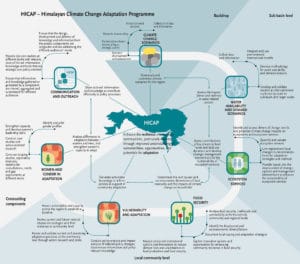 HICAP – a transboundary, inter-disciplinary and multi-scale programme
HICAP – a transboundary, inter-disciplinary and multi-scale programme
An infographic journey of the long road from science to policy impact - by Björn Alfthan (GRID-Arendal[1]), Nand Kishor Agrawal (ICIMOD[2]), Bob Van Oort[3] & Nina Bergan Holmelin (CICERO).
The Himalayan Climate Change Adaptation Programme (HICAP) was born out of a need to address critical knowledge gaps on the impacts of climate change in the Himalayas and to better understand under what conditions mountain communities can best adapt to change. Its main aims, elaborated in 2011, were to:
[caption id="attachment_3563" align="alignleft" width="300"]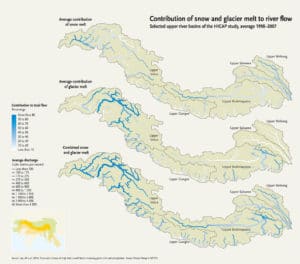 Glaciers are important for river flow but not necessarily the main source in all the rivers!
Glaciers are important for river flow but not necessarily the main source in all the rivers!
HICAP - a transboundary, inter-disciplinary and multi-scale programme
HICAP consisted of seven inter-linked components, starting by obtaining downscaled climate scenarios for the region, to projecting the impacts of climate change on water availability and ecosystems, through to examining the human dimension of impacts on food security and overall vulnerability to climate change. Gender and communications were components that cut across all the others.
Glaciers are important for river flow but not necessarily the main source in all the rivers!
The big question occupying scientists and policy makers alike – will the melting of Himalaya’s glaciers make a big impact on downstream water resources? – can only start to be answered by understanding the present-day contribution of different sources of water (glacier melt, snow, rainfall, groundwater) to river flow. One of the first tasks of HICAP was to do just that for the Indus, Ganges, Brahmaputra and Salween and Mekong. The Upper Indus basin’s runoff is dominated by glacial melt (41%), while rainfall is more important in other basins (up to 66% in the upper Ganges, for example). For the original scientific article, see: Lutz, AF et al. 2014. Consistent Increase in High Asia’s runoff to increasing glacier melt and precipitation. Nature Climate Change 4: 587-592.
[caption id="attachment_3561" align="alignright" width="300"]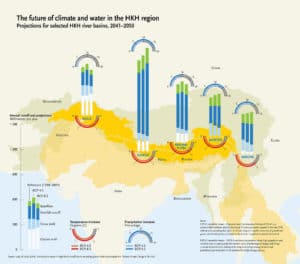 The water scenario until 2050
The water scenario until 2050
The water scenario until 2050
HICAP also included modelling work on projected changes in temperature and precipitation in the same upper basins of the Indus, Ganges, Brahmaputra, and Salween and Mekong, according to a number of emission scenarios (RCPs). The projections indicated that most of the Himalayas will increase by between 1-2°C and in places by up to 4-5°C. One of the main messages was that runoff within the upper river basins were not projected to decrease until at least 2050, although changes in spatial distribution of runoff might be significant, leading to high impacts in certain locations. An increase was even projected for the upper Ganges, Brahmaputra and Mekong. Many of these findings are also illustrated in the Himalayan Climate and Water Atlas and formed the basis of several policy recommendations.
[caption id="attachment_3559" align="alignleft" width="294"]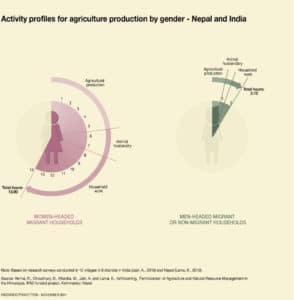 Climate Change, out-migration and gender: inseparable dynamics in the Himalayas
Climate Change, out-migration and gender: inseparable dynamics in the Himalayas
Climate Change, out-migration and gender: inseparable dynamics in the Himalayas
The HICAP programme spent a significant amount of effort understanding gender dynamics within mountain communities in the Himalayas and how this is evolving in the context of climate change, high male out-migration and other drivers of change. Women are on the frontline of having to deal with local hazards and impacts, bearing some of the greatest risks, and shoulder an increasing amount of responsibility and drudgery. Despite high levels of male outmigration for work, women still operate within a system that is highly patriarchal and denies their full participation. HICAP action research focused on strengthening women’s capacities to manage the associated risks through, for example, financial literacy training and skills training on resilient agricultural practices. HICAP’s Adaptation Solution Brief provides a useful overview of the issues, challenges and opportunities for strengthening the role of women as risks and resource managers in their own communities.
[caption id="attachment_3560" align="alignright" width="300"]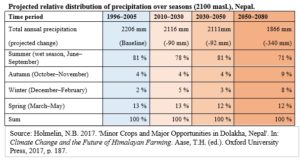 Farmer flexibility is key for adaptation
Farmer flexibility is key for adaptation
Farmer flexibility is key for adaptation
HICAP included in-depth ethnographic case studies of specific farming communities across the Himalayas, with cases from India, Nepal, Pakistan and China. The adaptive capacities and opportunities of farmers were identified, along with their existing constraints to continued food production and adaptation to climatic and other changes. This work demonstrated the great diversity of Himalayan farming systems, which are adapted and fine-tuned to their specific environments and local climates. Farmers who choose a flexible strategy, by making rapid adjustments to their crop composition and by keeping some buffers of unused capacity, are best prepared to tackle future rising temperatures and more unpredictable rainfall patterns. In one of the cases from Nepal, farmers reduce the risk of food insecurity following a drought, hailstorm or intensive rains by combining traditional staple production with new high-value cash crops such as spices, vegetables and tree products. Downscaled climate projections for this site developed under HICAP show that the farmers must expect less total rainfall, a more scattered monsoon that prolongs throughout the autumn, and a slight increase in winter rains. While less rain and a wetter harvest season is bad news for the staple production, flexible farming strategies enable people to exploit the emerging opportunity of winter cultivation of vegetables, which they export to the capital. The full results of the case studies are published in the academic book Climate Change and the Future of Himalayan Farming, published by Oxford University Press in 2017.
[caption id="attachment_3562" align="alignleft" width="300"]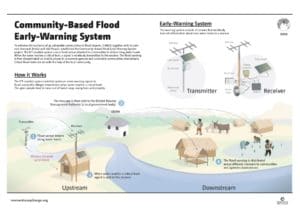 Early warning systems and other simple solutions can help the most affected people
Early warning systems and other simple solutions can help the most affected people
Early warning systems and other simple solutions can help the most affected people
On the ground pilot projects are important tools for testing approaches, technologies and assumptions on a manageable scale. One of HICAP’s most important and successful pilots was the Community-based flood early warning system (CB-FEWS), which provides the tools, technology and capacity necessary for communities to detect and respond appropriately to flood emergencies. The approach was first piloted in Assam to the benefit of 46 villages and about 21,000 people. It is now being replicated across the region. The system won the UNFCCC Lighthouse Award in 2014 and a short video is available.
The long road from knowledge, to seeing is believing, to policy impact
HICAP was initially a programme focused on generating knowledge through scientific research, but the mid-term evaluation pointed to the need to better connect this knowledge to policy makers. One aspect of this approach has been to develop a number of pilots (the flood early warning system being one of them). The pilots have been a cornerstone of HICAP’s policy engagement, serving to educate and convince local and national governments, as well as civil society, of the usefulness of certain adaptation approaches and how to create or reform policies to facilitate their uptake.
[caption id="attachment_3557" align="alignright" width="300"]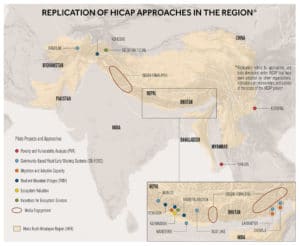 The long road from knowledge, to seeing is believing, to policy impact
The long road from knowledge, to seeing is believing, to policy impact
For further information
HICAP is an inter-disciplinary research programme implemented jointly by the International Centre for Integrated Mountain Development (ICIMOD), the Centre for International Climate Research – Oslo (CICERO) and GRID-Arendal, in collaboration with local partners, and is funded by the governments of Norway and Sweden.
Further information about HICAP and its publications can be found at: http://www.icimod.org/?q=10140
Many of the infographics and maps can also be downloaded from GRID-Arendal’s graphics library: http://www.grida.no/resources/types/graphic
[1] This email address is being protected from spambots. You need JavaScript enabled to view it.
[2] ICIMOD = International Centre for Integrated Mountain Development, This email address is being protected from spambots. You need JavaScript enabled to view it.
[3] CICERO = Centre for International Climate Research – Oslo, This email address is being protected from spambots. You need JavaScript enabled to view it.
Cover photo: Lawrence Hislop
 HICAP – a transboundary, inter-disciplinary and multi-scale programme
HICAP – a transboundary, inter-disciplinary and multi-scale programmeAn infographic journey of the long road from science to policy impact - by Björn Alfthan (GRID-Arendal[1]), Nand Kishor Agrawal (ICIMOD[2]), Bob Van Oort[3] & Nina Bergan Holmelin (CICERO).
The Himalayan Climate Change Adaptation Programme (HICAP) was born out of a need to address critical knowledge gaps on the impacts of climate change in the Himalayas and to better understand under what conditions mountain communities can best adapt to change. Its main aims, elaborated in 2011, were to:
- Reduce uncertainty through downscaling and customizing global climate change scenarios, and developing water availability and demand scenarios for parts of major river basins
- Develop knowledge and enhance capacities to assess, monitor, and communicate the impacts of and responses to climate change on natural and socio-economic environments at the local, national and regional levels
- Make concrete and actionable proposals for strategies and policies considering vulnerabilities, opportunities and potentials for adaptation, with particular reference to the role of women and local communities.
[caption id="attachment_3563" align="alignleft" width="300"]
 Glaciers are important for river flow but not necessarily the main source in all the rivers!
Glaciers are important for river flow but not necessarily the main source in all the rivers!HICAP - a transboundary, inter-disciplinary and multi-scale programme
HICAP consisted of seven inter-linked components, starting by obtaining downscaled climate scenarios for the region, to projecting the impacts of climate change on water availability and ecosystems, through to examining the human dimension of impacts on food security and overall vulnerability to climate change. Gender and communications were components that cut across all the others.
Glaciers are important for river flow but not necessarily the main source in all the rivers!
The big question occupying scientists and policy makers alike – will the melting of Himalaya’s glaciers make a big impact on downstream water resources? – can only start to be answered by understanding the present-day contribution of different sources of water (glacier melt, snow, rainfall, groundwater) to river flow. One of the first tasks of HICAP was to do just that for the Indus, Ganges, Brahmaputra and Salween and Mekong. The Upper Indus basin’s runoff is dominated by glacial melt (41%), while rainfall is more important in other basins (up to 66% in the upper Ganges, for example). For the original scientific article, see: Lutz, AF et al. 2014. Consistent Increase in High Asia’s runoff to increasing glacier melt and precipitation. Nature Climate Change 4: 587-592.
[caption id="attachment_3561" align="alignright" width="300"]
 The water scenario until 2050
The water scenario until 2050The water scenario until 2050
HICAP also included modelling work on projected changes in temperature and precipitation in the same upper basins of the Indus, Ganges, Brahmaputra, and Salween and Mekong, according to a number of emission scenarios (RCPs). The projections indicated that most of the Himalayas will increase by between 1-2°C and in places by up to 4-5°C. One of the main messages was that runoff within the upper river basins were not projected to decrease until at least 2050, although changes in spatial distribution of runoff might be significant, leading to high impacts in certain locations. An increase was even projected for the upper Ganges, Brahmaputra and Mekong. Many of these findings are also illustrated in the Himalayan Climate and Water Atlas and formed the basis of several policy recommendations.
[caption id="attachment_3559" align="alignleft" width="294"]
 Climate Change, out-migration and gender: inseparable dynamics in the Himalayas
Climate Change, out-migration and gender: inseparable dynamics in the HimalayasClimate Change, out-migration and gender: inseparable dynamics in the Himalayas
The HICAP programme spent a significant amount of effort understanding gender dynamics within mountain communities in the Himalayas and how this is evolving in the context of climate change, high male out-migration and other drivers of change. Women are on the frontline of having to deal with local hazards and impacts, bearing some of the greatest risks, and shoulder an increasing amount of responsibility and drudgery. Despite high levels of male outmigration for work, women still operate within a system that is highly patriarchal and denies their full participation. HICAP action research focused on strengthening women’s capacities to manage the associated risks through, for example, financial literacy training and skills training on resilient agricultural practices. HICAP’s Adaptation Solution Brief provides a useful overview of the issues, challenges and opportunities for strengthening the role of women as risks and resource managers in their own communities.
[caption id="attachment_3560" align="alignright" width="300"]
 Farmer flexibility is key for adaptation
Farmer flexibility is key for adaptationFarmer flexibility is key for adaptation
HICAP included in-depth ethnographic case studies of specific farming communities across the Himalayas, with cases from India, Nepal, Pakistan and China. The adaptive capacities and opportunities of farmers were identified, along with their existing constraints to continued food production and adaptation to climatic and other changes. This work demonstrated the great diversity of Himalayan farming systems, which are adapted and fine-tuned to their specific environments and local climates. Farmers who choose a flexible strategy, by making rapid adjustments to their crop composition and by keeping some buffers of unused capacity, are best prepared to tackle future rising temperatures and more unpredictable rainfall patterns. In one of the cases from Nepal, farmers reduce the risk of food insecurity following a drought, hailstorm or intensive rains by combining traditional staple production with new high-value cash crops such as spices, vegetables and tree products. Downscaled climate projections for this site developed under HICAP show that the farmers must expect less total rainfall, a more scattered monsoon that prolongs throughout the autumn, and a slight increase in winter rains. While less rain and a wetter harvest season is bad news for the staple production, flexible farming strategies enable people to exploit the emerging opportunity of winter cultivation of vegetables, which they export to the capital. The full results of the case studies are published in the academic book Climate Change and the Future of Himalayan Farming, published by Oxford University Press in 2017.
[caption id="attachment_3562" align="alignleft" width="300"]
 Early warning systems and other simple solutions can help the most affected people
Early warning systems and other simple solutions can help the most affected peopleEarly warning systems and other simple solutions can help the most affected people
On the ground pilot projects are important tools for testing approaches, technologies and assumptions on a manageable scale. One of HICAP’s most important and successful pilots was the Community-based flood early warning system (CB-FEWS), which provides the tools, technology and capacity necessary for communities to detect and respond appropriately to flood emergencies. The approach was first piloted in Assam to the benefit of 46 villages and about 21,000 people. It is now being replicated across the region. The system won the UNFCCC Lighthouse Award in 2014 and a short video is available.
The long road from knowledge, to seeing is believing, to policy impact
HICAP was initially a programme focused on generating knowledge through scientific research, but the mid-term evaluation pointed to the need to better connect this knowledge to policy makers. One aspect of this approach has been to develop a number of pilots (the flood early warning system being one of them). The pilots have been a cornerstone of HICAP’s policy engagement, serving to educate and convince local and national governments, as well as civil society, of the usefulness of certain adaptation approaches and how to create or reform policies to facilitate their uptake.
[caption id="attachment_3557" align="alignright" width="300"]
 The long road from knowledge, to seeing is believing, to policy impact
The long road from knowledge, to seeing is believing, to policy impactFor further information
HICAP is an inter-disciplinary research programme implemented jointly by the International Centre for Integrated Mountain Development (ICIMOD), the Centre for International Climate Research – Oslo (CICERO) and GRID-Arendal, in collaboration with local partners, and is funded by the governments of Norway and Sweden.
Further information about HICAP and its publications can be found at: http://www.icimod.org/?q=10140
Many of the infographics and maps can also be downloaded from GRID-Arendal’s graphics library: http://www.grida.no/resources/types/graphic
[1] This email address is being protected from spambots. You need JavaScript enabled to view it.
[2] ICIMOD = International Centre for Integrated Mountain Development, This email address is being protected from spambots. You need JavaScript enabled to view it.
[3] CICERO = Centre for International Climate Research – Oslo, This email address is being protected from spambots. You need JavaScript enabled to view it.
Cover photo: Lawrence Hislop
Related Posts
By accepting you will be accessing a service provided by a third-party external to https://mountainresearchinitiative.org/






